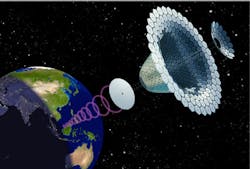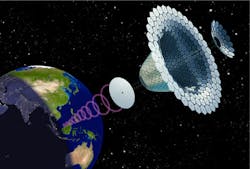Solar modules for beaming power to Earth
A researcher at the Naval Research Laboratory has constructed a module designed to be put in orbit around Earth and collect solar power, transform it into microwaves, and transmit them to Earth where they would be converted to usable electricity. The military wants to use the technology to power remote bases and for humanitarian purposes.
In the Navy design, the module receives solar energy on a photovoltaic panel on one side; electronics in the middle convert the direct current into a radio frequency (RF); and the backside has an antenna that beams the power to Earth. The module is four times more efficient than any previous device for turning solar energy to RF. To get rid of the heat built up by the sun and electronics, the module unfolds into a zig-zag pattern. It lets the module radiate heat more efficiently and, thus, receive greater concentrations of sunlight without overheating.
To make the module economical, robots would assemble a horde of them to form an array more than half a mile, or nine football fields in diameter. (The largest object currently in orbit is the International Space Station, which stretches a little more than a football field from end to end.) The array would also include large solar reflectors to boost the amount of sunlight falling on the modules.
There are concerns about shooting a concentrated beam of power through the atmosphere. Several precautions are being considered. The module would only send energy to specified receivers that signaled they wanted it. Using microwaves to send the power to Earth should be much safer than using high-energy lasers. The modules could use a lower frequency, thus reducing the power concentration. But this would mean larger transmitters and receivers. It would, however, yield a side benefit: Power could be sent to Earth regardless of the weather. At 2.45 GHz, the researcher says he could beam electricity through a monsoon.
There are also plans to reduce the module’s weight to lower the costs of placing them in orbit. To this end, the Navy will experiment with thinner solar panels, a flatter and lighter antenna, and converting the chunky prototyped RF boards into a monolithic microwave integrated circuit, putting the entire PCB onto a chip.


